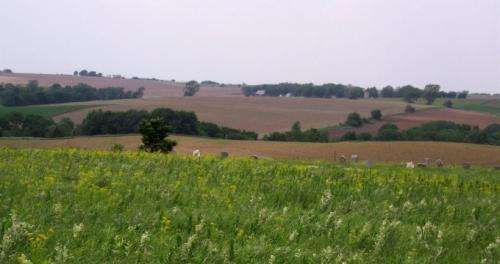Tallgrass prairie restoration could be bolstered by understanding rare microbes

(Phys.org) —In the first half of the nineteenth century, American settlers pushed westward into the Great Plains, lured to the prairies by the agricultural promise of their dark, rich soils.
Within a century, America's tallgrass prairies—which once stretched across more than 150 million acres, from Minnesota south to Texas and from Illinois west to Nebraska—had all but vanished under settlers' plows. The demise of the tallgrass prairie also meant the demise of dozens of species of grasses that could grow to the height of a man, hundreds of species of flowers and herds of roaming bison.
The prairie's destruction also doomed a less-obvious form of life: the teeming collection of microbes that helped create the fertile prairie soil. For the first time, a research team led by the University of Colorado Boulder has gotten a glimpse of what the community of tiny bugs that lived under the tall grasses might have looked like.
"These soils played a huge role in American history because they were so fertile and so incredibly productive," said Noah Fierer, a fellow at the Cooperative Institute for Research in Environmental Sciences. "They don't exist anymore except in really small parcels. This is our first glimpse into what might have existed across the whole range."
Fierer and his colleagues examined 31 soil samples taken from the last remnants of tallgrass prairies—which mostly exist only in old cemeteries and nature preserves—to determine what kinds of microbes live there.
"It was very hard to find sites that we knew had never been tilled," Fierer said. "As soon as you till a soil, it's totally different. Most gardeners are familiar with that."
The results of the study, which are published in the journal Science, show that a poorly understood phylum of bacteria, Verrucomicrobia, dominated the microbial communities in the soil, though the microbial makeup of each particular soil sample was unique.
Fierer and his colleagues are already hard at work trying to grow Verrucomicrobia in the lab to better understand what it does and the conditions it favors. But even without a full understanding of the microbes, the research could bolster tallgrass prairie restoration efforts in the future.
"Here's a group that's really critical in the functioning of these soils. So if you're trying to have effective prairie restoration, it may be useful to try and restore the below-ground diversity as well," Fierer said.
Journal information: Science
Provided by University of Colorado at Boulder

















